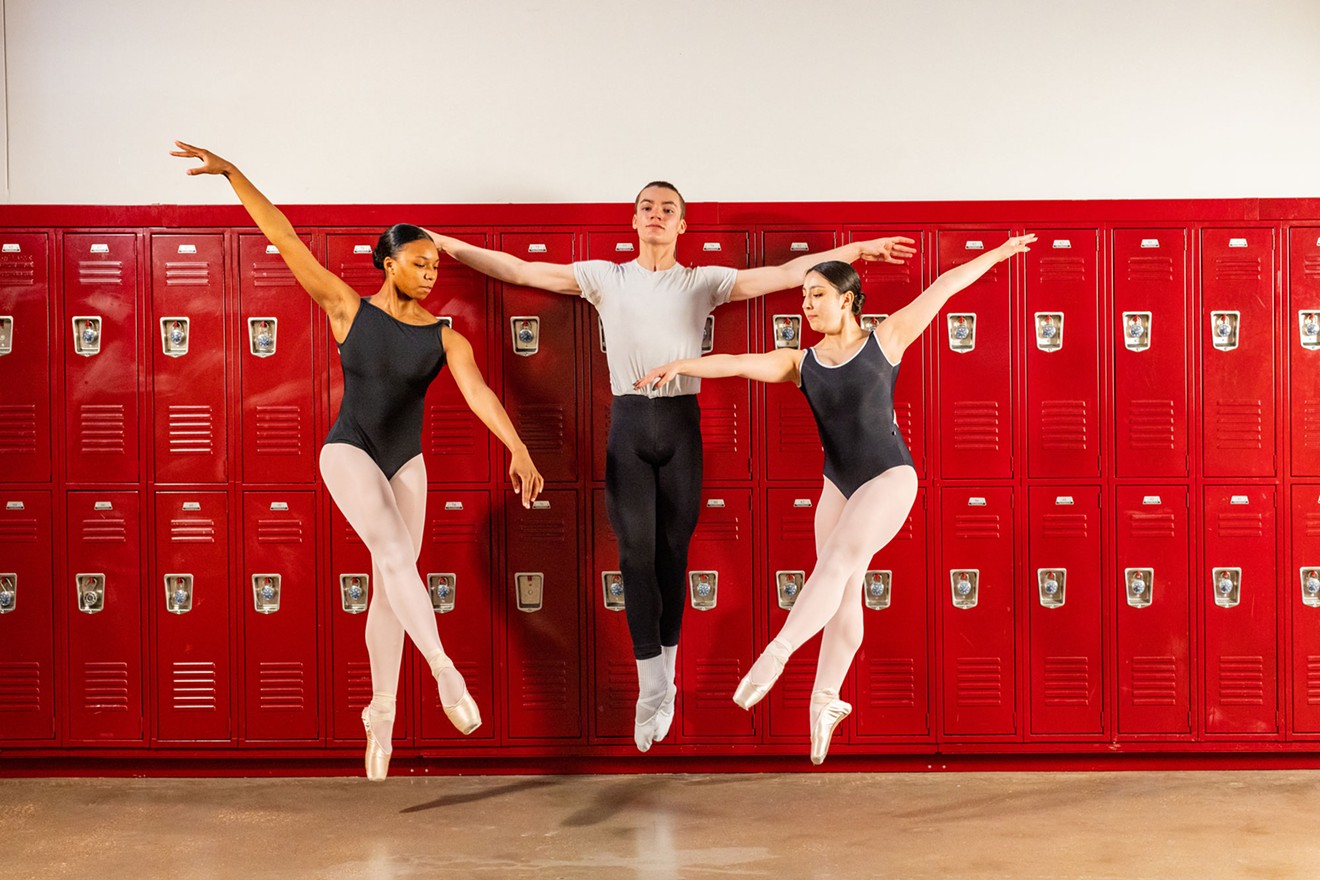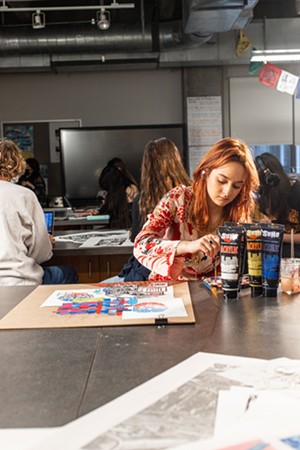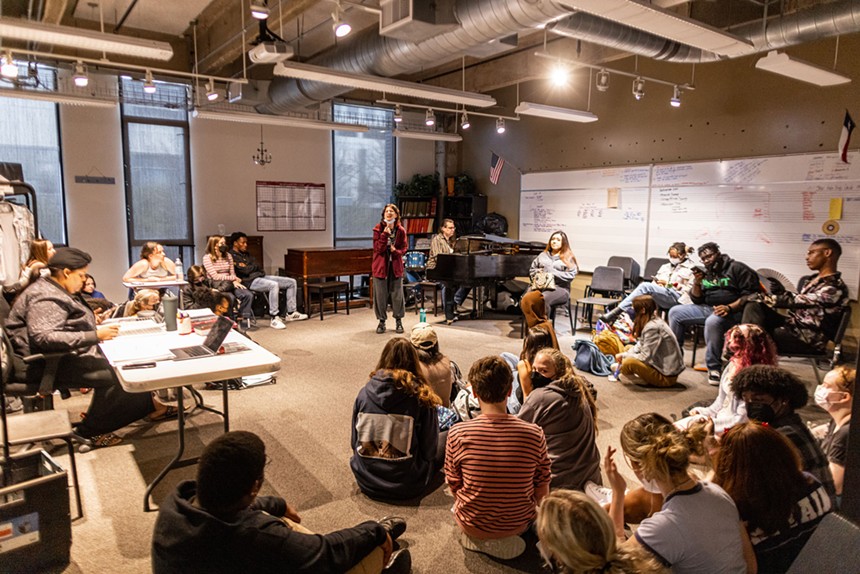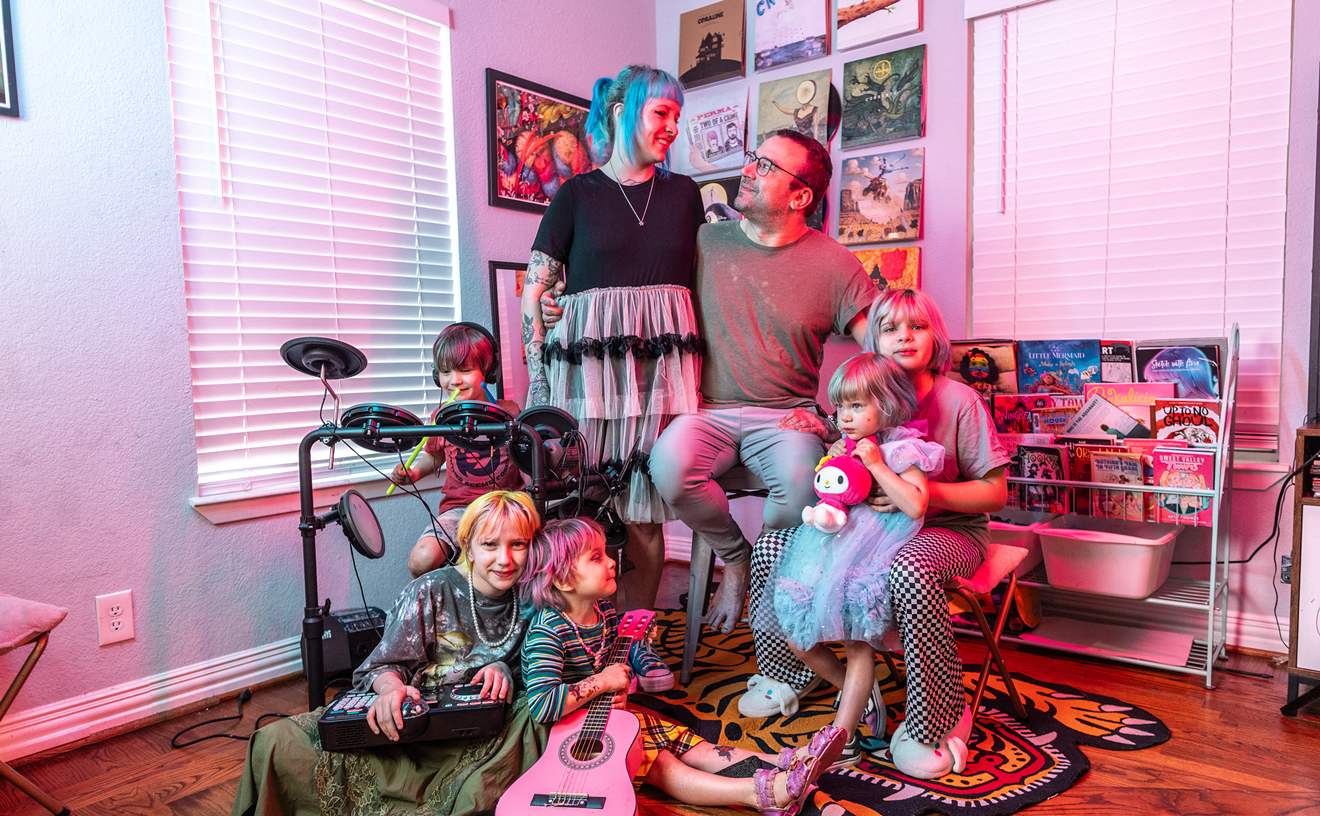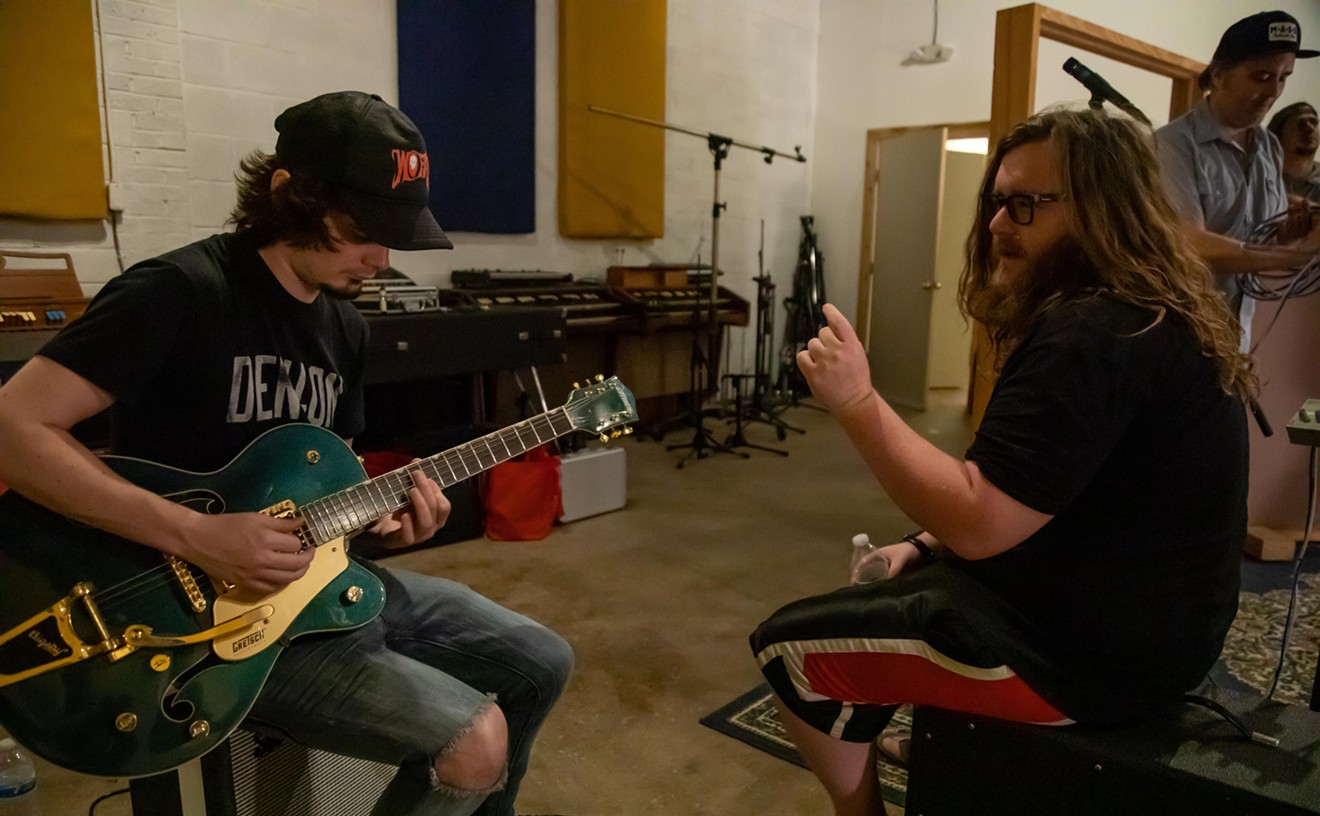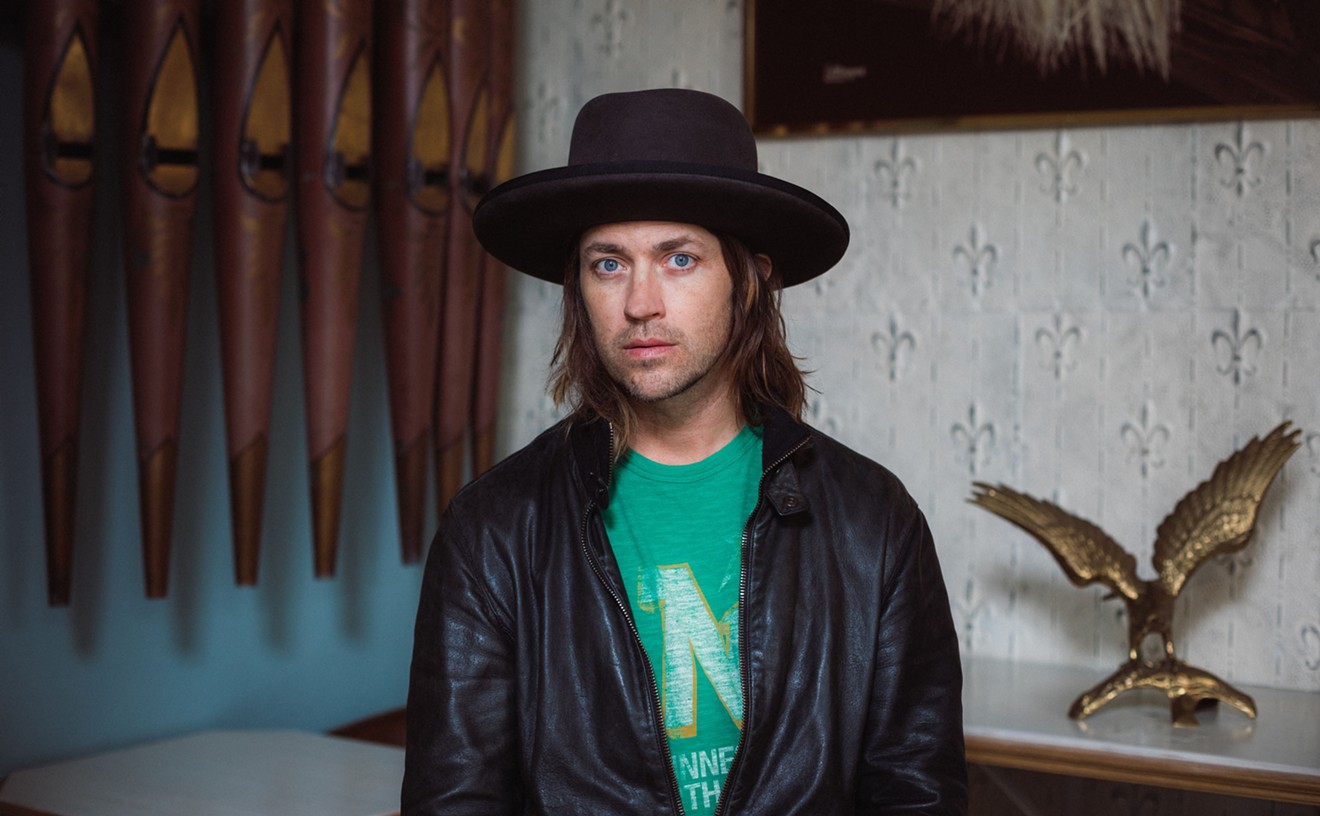The sound of students performing violin scales in the hallways echoes off the granite floors and walls from the top floor all the way to the reception area. Some of the two-story classrooms are filled with rows of dance students practicing their arabesques and battements in dance wear to sweeping, classical compositions. The first act of Alexander Glazunov's Raymonda and Johann Sebastian Bach's "Goldberg Variations" set the scenes.

Piano and music theory instructor Leonardo Zuno Fernández offers performance advice to his student.
Kathy Tran
On the next floor up, the students in theater teacher M.T. D'Avignon's class are either sitting behind a sewing machine or piecing together a replica of an 18th century petticoat, dress and pannier for a University Interscholastic League competition that's just two days away. The students are so engrossed in their work and details that they don't seem to notice our presence.
Just down the hall from them, the students in art instructor Krystal Read's class are preparing intricate designs for a printmaking project, a complex medium made from a multitude of materials that the Dallas Museum of Art described from a previous student exhibition as "an act of construction."
"We get to work with specialized equipment and very specific classes," says Read, who's also a Booker T. graduate and the school's assistant director for the visual arts conservatory. "We're just keeping up with the top tier standards this school has. There's a lot of pressure for the teachers and students to perform as well."
The tone rings and students wrap up their projects and belongings for their next classes. Senior Moses Turgeman strums a tune on a guitar as he walks up the stairs. This is a familiar sight and sound for the faculty and students.
"I'm gonna miss you when you graduate," Sharon Cornell, the school's public relations specialist, tells him. "I like hearing you in the halls."
A school like Booker T. Washington is a rarity, beginning with its strong support and focus on balancing artistic and academic education for the 250 students who earn a spot each year. It's a unique place that can boast of fostering and shaping the talents and minds of Grammy-winning artists such as Edie Brickell, Norah Jones, Erykah Badu, Roy Hargrove, Alan Emert and Danny O'Brian of Brave Combo, 18 members of the God's Property gospel choir and playwright Theodis "Ted" Shine, who recently earned the school its first Literary Landmark designation from the Texas State Library and Archives Commission.
"I came from Catholic school where I had to wear uniforms every day," says Badu, who graduated from Booker T. in 1989 and sent her daughter Puma to the high school for its singing conservatory. "I felt like I wasn't able to really express myself aesthetically. So when I got into Booker T. as a dancer, and I wasn't necessarily a great dancer but I was expressive enough to get in, it was a world of freedom for me."
Some of its more famous students, like Badu, Jones and others, still show up at times to sing and perform with the students and even bring along other famous and talented names like Common, who stopped by the school with Badu in 2019.
Booker T. Washington High School is now a century-old monument to the history and evolution of Dallas' culture.
"It truly is the shoulders of the giants that we stand on," says Dr. Scott Rudes, Booker T.'s principal. "This school was founded by true pioneers who fought and prided themselves on receiving an education. They were visionaries. They were creators, and then to have the school transformed into an arts magnet that also celebrates that innovation, creativity and commitment to pushing the envelope is a testament to the legacy of those that came before us."
The building that houses the Flora Street school in the heart of the Dallas Arts District opened on Oct. 30, 1922 as a high school for African Americans, the only one in Dallas' segregated school district for its first 17 years of existence, according to its historical landmark designation report.
The school added "Technical" to its title in 1952 following a $1 million renovation, making it the first technical African American high school in the Southwest. Some notable alumni from its "Bulldog years," referring to the school's first mascot, include former DISD teacher and administrator Dr. Thomas Tolbert, pioneering Dallas Morning News columnist and journalist Julia Scott Reed and sports legends such as world welterweight boxing champion Curtis Cokes and Major League Baseball Hall of Famer Ernie Banks, who's honored with a statue on the school's grounds.
The school achieved many firsts in regional education: It was the first Dallas school to broadcast a football game on radio, the first school in the Southwest to teach an accredited course in African American life and history and the first to found a National Honor Society chapter, according to historical reports.
"[Booker T.] was kind of different in a way because before then we were not allowed to do a whole lot of things," says Ruthie Walker, who graduated from Booker T. Washington Technical High School in 1967 and served as her graduating class' student council president. "It gave us a lot of opportunities to get jobs where we couldn't get them."
Even before the school became an arts magnet, Booker T.'s students got a healthy dose of arts education and exposure, Walker says.
"We got to go to the opera," she says. "We got to go to the symphony. We got to do a whole lot of stuff we weren't introduced to at K.B. Polk [Elementary]."
Booker T. Washington closed in 1969 as part of a districtwide desegregation order. Dr. Paul Baker, a renowned theater teacher and one of the founders of the Dallas Theater Center (DTC) in 1959, led an effort to make Booker T. into an arts magnet school upon its reopening in 1976.
"Most of these schools exist because of a desegregation order just like this one," says Guinea Bennett Price, an '89 alumnus of Booker T. who is also the co-founder and co-artistic director of the Soul Rep Theatre Company and the high school's theater conservatory director.
Nolan Estes became DISD's superintendent in 1968 and worked with Baker to establish an arts curriculum and program expansions for students and teachers. Louise Mosely Smith, a former head of the school's theater division who worked with Baker at DTC and his Children's Theater program, wrote in an essay for the book Paul Baker and the Integration of Abilities that new strategies in "career education" were being implemented across the country to "engage the whole person or relate to life."
This led to the creation of magnet schools such as the Skyline High School in 1971, which taught academic subjects for half of the day and let students work on "practical projects in their chosen career field" for the rest of the day, Smith wrote.
The following year, Baker wrote a book called Integration of Abilities outlining methods and techniques he developed and implemented while teaching drama and theater at Trinity and Baylor University. Baker lays out new teaching techniques that use students' sensory awareness and creative expression across all mediums to help students "discover their creative ability" and "help the theater catch up with the progress made in the other arts," according to TSU archives.
DISD created an exploratory group called The Alliance that advised the district to create magnet schools focused in career curriculums such as science, business, law and the arts. Baker became the director of the arts magnet school project and sought hundreds of thousands in funding to hire professional artists to advise and teach at the school, a decision he made after attending a National Conference of Magnet Schools in Houston where he and Smith met the founder of the renowned Houston High School for the Performing and Visual Arts, Ruth Denney, Smith wrote.
Meanwhile, the building for Booker T. Washington High School had been out of operation since the desegregation order and was being used as a meeting space and storage facility for the district's PTA. Smith wrote they chose to visit the building as the first possible site because of its proximity to the DTC, and it immediately bowled them over with its possibilities.
"It was love at first sight and smell," Smith wrote. "As we walked through the halls with the high ceilings, the lovely wooden cabinets and floors and the courtyard next to the cafeteria, we envisioned a small theater in the former choir room and a drawing classroom in the old homemaking room; we began planning how to turn the auditorium with its balcony into a usable theater with a light booth and dressing rooms."
Following Booker T.'s commencement of operations, arts magnet schools started to pop up in other major cities through the rest of the late '70s, and that led to the creation of the non-profit Arts School Network in 1981, Price says.
"A network was created and the Booker T. staff was there at the beginning of that art network; we were one of the founding schools for that and it's still going strong to this day," she says. "That was a way for us to always sort of feel like sister schools, like we have a reciprocity program. If one of our kids, say their dad's job moves to Washington, D.C., then [the Duke Ellington School for the Arts] without audition will allow our students to enroll. When Hurricane Katrina happened, we were able to take the [New Orleans Center for the Creative Arts] kids."
It took time for the diversity of Booker T.'s student body to grow following its reopening. A lawsuit filed in 1970 in federal court by Sam Tasby against DISD showed that school districts like Dallas were not meeting legal requirements for desegregation.
U.S. District Judge Barefoot Sanders, who oversaw the case for most of his long career on the bench, ruled in 2003 that the district achieved "unitary status" in "closing the achievement gap" even as then-Superintendent Dr. Mike Moses noted in his testimony that "much remains to be done," according to court filings. DISD has a middle school named in Tasby's honor.
"It's changed exponentially in the last eight years," Price says, referring to her time as a teacher at Booker T. Washington. "The year I came in, in the senior class, there were zero Black boys. There was one junior and he left. So the next senior class didn't have one either, and my son's class had four. I was determined that we would hold onto these four and have more every year after that and every year, that number has gone up."
Rudes says the school and the district remain committed to programs that help them seek out "students who have talent, drive and passions in the various sectors of our city who may not have been immersed in the arts."
Booker T. Washington High School's curriculum consists of four artistic "conservatories": theater, visual arts, music and dance in addition to academic studies. Students who wish to attend the school must have at least a 75 percent cumulative grade point average or 80 percent for students from the district's gifted and talented or science and engineering schools. All DISD magnet schools also require students to place in a certain percentile on the State of Texas Assessments of Academic Readiness (STAAR) or the Measures of Academic Progress (MAP) tests depending upon the student's grade level and school, according to the district's website.
Students who pass those bars participate in "in-person assessments" and must prove residency. DISD tried to crack down on students who filed false residency records in response to reports of rampant abuses of the rule in 2020 that included a tip hotline to weed out students who weren't living in the district.
Thirty percent of the students are selected based on overall scores, and the other 70 percent go through the district's feeder pattern guidelines based on student populations with considerations given to siblings of current or graduated students "who [attend] the same Vanguard, magnet Montessori or Academy program," according to the guidelines.
Rudes says the school receives strong, continuous support from the district and the school's advisory board, the latter of which has been able to raise millions in private donations for supplies, programs, renovation projects and expansions to its historic headquarters. The school boasts impressive numbers for student scholarships that reached as high as $78 million for a single graduating class.
"It's pretty magical," says Kate Walker, the high school's dance conservatory director. "These kids are incredibly talented and keep me on my A-game. I learned pretty quick that I can't rest on my laurels in the same way I don't expect them to. It's helped me grow a lot as an instructor. The level of instruction and talent is through the roof. I have to remind myself they are teenagers. As you're watching them, it's easy to forget they're 13 or 14 years old .... and then someone will say something funny and you remember."
Artist Chris Arnold, who graduated from Booker T.'s visual arts conservatory in 1984 and later founded Eyecon Studios with Jeff Garrison, now paints and restores multistory murals all over the city and country, with works at the Southwest Airlines corporate headquarters and Walt Disney World resorts in Orlando. One of his first Dallas murals covered the side of a parking garage located across the street from Booker T. He says the things he learned from his art education at Booker T. showed him more than just how to hold and use a paintbrush: They taught him and other students like him how to be an artist.
"The staff at the school were all incredibly talented professionals and were willing to give of their time. They brought in their peers and fellow artists to help teach the kids in a nurturing environment," Arnold says. "There were super passionate and really cared about educating the kids, and their passion rubbed off on us and definitely fired us up. The school itself by its nature is a magnet school, so it draws people in and you have to be really on point and passionate about what you do to be in that school."
An education with a strong focus on fostering and teaching the art and exploration of expression doesn't just have application to students' technical abilities to become singers, actors, dancers or artists. Many of the school's staff members note that lessons in those areas can also teach skills like focus, problem solving, confidence and determination that apply to a wide variety of ventures and careers.
"That level of discipline translates really well into any career path," Walker says. "I see lots of students pave their own way whether it's as artists or not. They are leaders."
The school already has a long and impressive list of names of people who work in front of and behind the scenes in show business, but they also include names like Ford Motor Co. chief designer Earl Lucas, civil and labor attorney Tammy Wood of the Bell Nunnally law firm of Dallas and WinCo Foods' corporate communications director Noah Fleisher.
"You're becoming empowered to be your own artist, to learn how you function as an artist," Price says. "What is my personal process? These four years helps you figure that out, and once you move beyond this space and someone throws a project at you, you go into your systems that you developed in these four years and it just makes putting things together just so much easier. You know the best way for yourself because you've had a chance to try it many ways in collaboration by yourself and once you've got that, you can apply it to anything."
Smith wrote that Baker's educational philosophy believed "every student is creative and that creativity applies to all areas of the student's life; therefore, every student should try every aspect of theater."
Arts magnets school like Booker T. Washington High School don't just create artists. Badu says Booker T. brings out the artistic and expressive vision that's already there.
"That creativity and expressing myself in my style kind of opened me up with every other artform," Badu says. "The freedom of those halls, it was a whole new world for as the artist in me was awakening."

